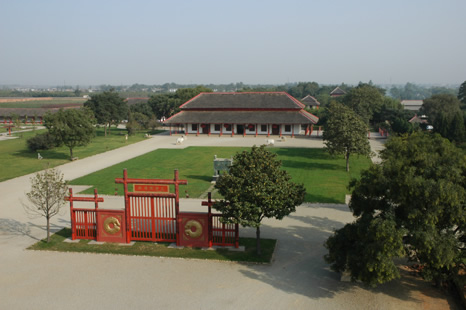Turquoise Inlaid Ivory Cup: A Luxury Taste of Wine
[sources] 1. 游山玩水 2. showchina.org
Name: Turquoise Inlaid Ivory Cup | 中文名: 嵌绿松石象牙杯
Dated to: ~1,300-1,100 B.C. | Culture: late Shang Dynasty
Unearthed: 1975 A.D. @ Anyang, Henan | Current location: Archaeology Institute of Chinese Academy of Social Sciences
Dimension: diameter: 11.2-12.5cm; height 30.5cm
Yinxu – the Oldest proved capital ruins
This ivory cup was unearthed from The Tomb of Lady Fu Hao at Yinxu, one of the oldest and largest archaeological sites in China and is one of the Historical capitals of China and a UNESCO World Heritage Site. Yinxu is famous as the original source of oracle bones and oracle bone script, the earliest recorded form of Chinese writing.
As one of the best-preserved Shang Dynasty royal tombs and the only one not to have been looted before excavation, The Tomb of Lady Fu Hao was discovered in 1976 and identified as the final resting place of the queen and military general Fu Hao. Tens of thousands of relics were unearthed from this tomb. This ivory cup is one of five ivory objects.
Turquoise Inlaid Ivory Cup: A Luxury Taste
The cup is made of hollow root segment of an ivory with a designing ingenuity according to the shape of material. It has a curvy mouth, thin lips, and narrower waist. Its bottom is slightly narrower than its mouth.

Kui - A dragon-shaped mythology beast
At the side of cup body there is a Kui-shaped handle. Shaped as head-up-tail-down Kui, the handle is also embedded with turquoises, plus beast face and beast head ornaments. Two symmetrical small round tenons connect the handle to cup body.
This ivory cup, using relief, line engraving, inlay, etc. a variety of techniques, is a rare art treasure.
Delicate decorative patterns
Carved patterns on the cup body have a very fine decorative nature. Except that the bottom and mouth regions are left plain, strips of turquoise divided the cup decoration into four sections.

A typical {link:http://en.wikipedia.org/wiki/Taotie}Taotie{/link} motif
The first section has three groups of Taotie, with body and tail at each side of Taotie. Their eyes, eyebrows, nose are inlaid with turquoise.
The second section is the upper body part of the cup. Two groups of Taotie in this section have very clear facial structure, a big triangular pattern below the animals’ mouths. On both sides of triangular pattern, there is a symmetrical Kui pattern, head down and tail up. Mouths, eyes, noses and triangular patterns of Taotie are inlaid with turquoise.
Third section consists of three derived Kui pattern, with turquoise inlaid eyes. Three turquoise belts separate the third from the fourth section.
The fourth section has three groups of Taotie, with turquoise inlaid eyes and noses.
First, second, and fourth sections are all decorated with three groups of Taotie, but the shapes are unique and different.
[Forbidden Treasure of China Series]
This is the 9th of 64 culture heritages that the government of China forbids to exhibit abroad. The complete list is here. In Chinese.
[Chinese Keywords]
国家一级文物 禁止出境







It’s amazing how well-preserved it is.